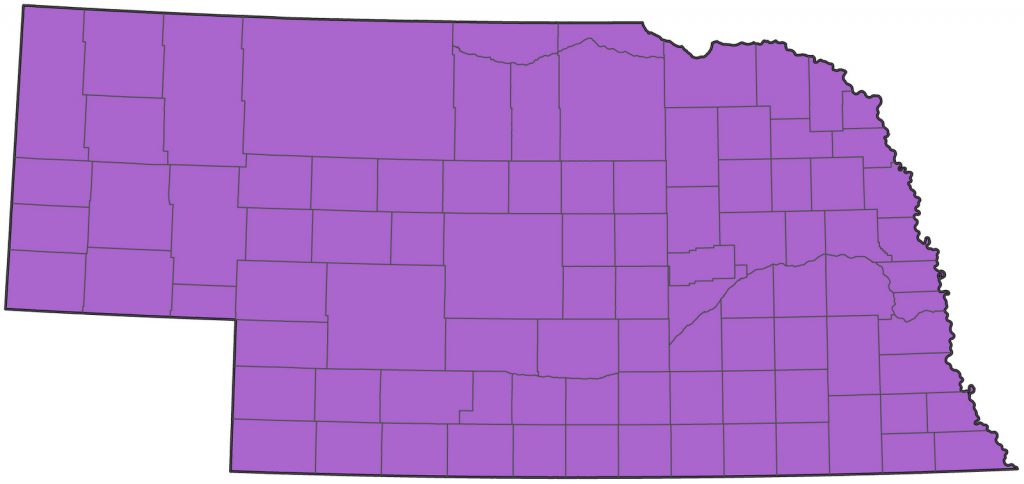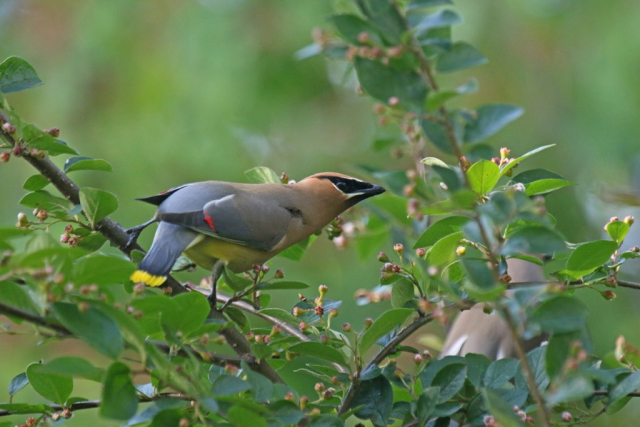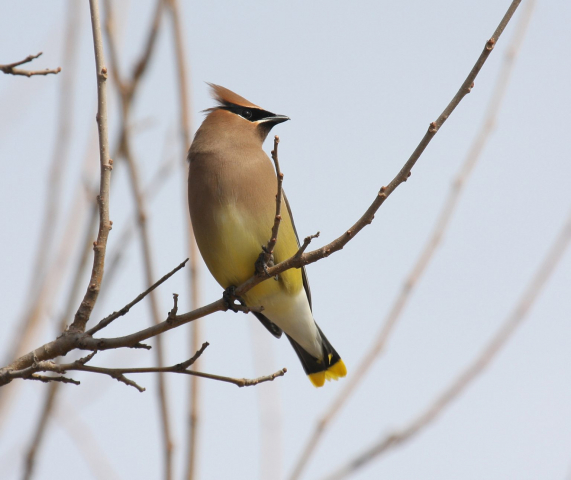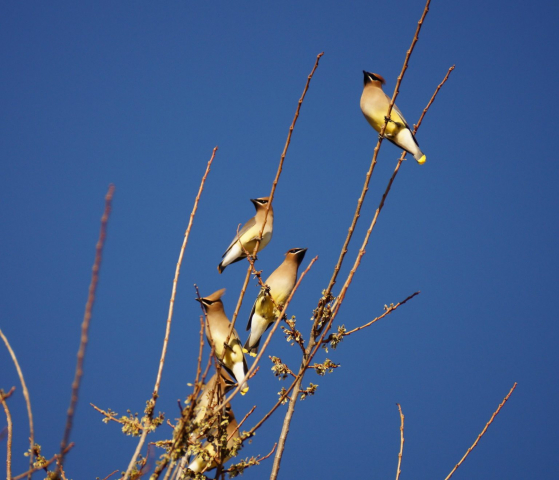Bombycilla cedrorum
Status: Common regular spring and fall migrant statewide. Fairly common regular breeder east and central, uncommon west. Common regular winter visitor statewide.

Documentation: UNSM ZM12051, 8 Mar 1890 Lancaster Co.
Taxonomy: No subspecies are recognized (AviList 2025, Witmer et al 2020).
Changes since 2000: This species has increased in summering numbers and especially westward since the mid-1990s (Mollhoff 2001, 2016). Mollhoff (2016) found an increase in the percentage of survey blocks reporting this species from 14% to 47% between 1989-1994 and 2006-2011. BBS trend analysis indicate the species has increased annually at a rate of 8.30% (95% C.I.; 4.65, 12.55) statewide 2003-2019 (Sauer et al 2020).
Spring: Cedar Waxwings are observed commonly in winter and because of this, timing of spring and fall migration is difficult to determine; movements are probably a mix of wandering and true migration (Witmer et al 2020).
Spring migration takes place mainly in Mar and Apr, although Robbins and Easterla (1992) observed two peaks during spring migration, an early one in Mar (which may be difficult to discern due to the presence of wintering birds), and a later peak in late May and early Jun. Robbins and Easterla (1992) suggested that the late peak is of birds wintering further south than the early peak, perhaps as far south as Mexico and Central America.
- High counts
- Early high counts: “thousands” (12-15 flocks of 300-500) in southeast Lincoln Co 19 Apr 2010, 2000 in North Platte, Lincoln Co 28 Mar 1927 (Tout 1947), 1575 in southeast Lincoln Co 8 Apr 2015, and 500 at Harlan Co Reservoir, Harlan Co 23 Apr 1999, “hundreds and hundreds” in southeast Lincoln Co cedar canyons 8 Apr 2016
Late high counts: “hundreds”, including one flock of 300+, in Lincoln Co 28 May 2004, 300 on Kilgore Road, Buffalo Co 22 May 2024, 250 in Dixon Co 21 May 2006, 200 in Gage Co 18 May 2022, and 200 at Cottonmill Park, Buffalo Co 16 May 2024. - The 36 at Fontenelle Park, Douglas Co 5 Jun 2023 was a late flock.
- A count of 425 in Banner Co 7 May 2020 is between the peaks suggested above.
Summer: Mollhoff (2001, 2016) showed a marked increase (from 15% to 47% of occupied blocks) in breeding season reports of Cedar Waxwing between 1989-1994 and 2006-2011. There was a general increase in observations throughout the state, but westward spread was notable in major river drainages, especially the Loup and Republican, as well as in the Pine Ridge. Mollhoff (2016) proposed that part of the increase noted in breeding records “may be due to the massive expansion of Eastern Red Cedar in the state”. BBS trend analysis 1966-2019 (Sauer et al 2020) shows Cedar Waxwing numbers increased substantially statewide 8.30% (95% C.I.; 4.65, 12.55) per year. Lowest numbers are found in the western Sandhills.
Cedar Waxwings are not conspicuous during the nesting season, likely because they are late nesters, breeding during mid- to late summer (see Breeding Phenology).
Although there was a notable increase in breeding reports on the Pine Ridge between 1989-1994 and 2006-2011 (Mollhoff 2016), Cedar Waxwing had been a rare to uncommon summer resident in the northwest up until the 1980s (Rosche 1982).
This general trend of recently increasing breeding numbers in the Panhandle and westerly stretches of major river drainages is emphasized by the scarcity of breeding records cited by Sharpe et al (2001) in those areas prior to 2000. In the central Niobrara River Valley, Brogie and Mossman (1983) did not detect nesting in the Niobrara Valley Preserve, although Youngworth (1955) took specimens in northeast Cherry Co in 1932 and considered it a rare breeder there. Fledged young were at Valentine NWR, Cherry Co 28 Jul 1984 (McDaniel; Mollhoff 2022). In the Loup drainage, there were only breeding season reports without nesting evidence prior to 2000. Even in the Platte and North Platte River Valleys, the only apparent nesting record was of a “nesting pair” near Kingsley Dam, Keith Co May 1994 (Brown et al 1996). There are, however, numerous breeding season (Jun-Jul) reports since 2000 without nesting evidence from the Platte and North Platte river valleys (eBird.org, accessed Nov 2023). The Republican River Valley yielded only one nesting report prior to 2000, two nests in Dundy Co 31 May 1985 (Williams 1985), a rather early nesting date; two nests were constructed in Frontier Co by 30 Jun 2002.
- Breeding phenology:
- Copulation: 16 Jun
- Nest building: 11 May-15 Jul (Mollhoff 2022)
Eggs: 27 May-25 Jul (Mollhoff 2022)
Nestlings: 29 May-27 Jun
Fledglings: 20 Jun-27 Sep - A storm-damaged nest was rebuilt 5 Aug 2024 and incubation followed but attempt was abandoned 12 Aug.
Fall: Flocks of migrants are observed as early as Aug, but most arrive in mid-Sep and peak in Oct. A flock of 36 was at Fontenelle Forest, Sarpy Co 27 Aug 2006, 30 were in Garfield Co 28 Aug 2024, and 30 were in Gage Co 31 Aug 2019. A fly-catching flock of 55 at Johnson Lake, Gosper Co 6 Jul 2001 was most likely a concentration of adults around a good food source at that date. Numbers generally decline into winter.
- High counts: “several hundred” fly-catching at Indian Cave SP, Nemaha and Richardson Cos 12 Oct 2001, 300 in Fremont, Dodge Co 12 Oct 2021, 200 at North Platte 10 Oct 2006, 170 at Pawnee Lake SRA, Lancaster Co 27 Nov 2024, and 158 in Lancaster Co 19 Oct 2012.
Winter: Overwintering numbers are variable. CBC data 1980-2006 indicate that Cedar Waxwings are still fairly evenly distributed across the state by late Dec; the highest CBC count was 1742 at Calamus-Loup 1 Jan 2005.
Rosche (1982) noted that not since 1973-74 had Cedar and Bohemian waxwings been common at the same time, although good numbers of both occurred in the west 2004-2005.
- High counts: 800+ at Alma, Harlan Co 1 Jan 1999, 450 at Branched Oak Lake, Lancaster Co 1 Feb 2025, 309 in Lancaster Co 28 Feb 2014, and 250 in Cass Co 21 Jan 2012.
Comments: In spring 2014 there were several reports of dead Cedar Waxwings in eastern Nebraska. Jorgensen (2014) researched possible causes and found that most of the deaths were associated with cotoneaster shrubs (Cotoneaster sp.), which produce berries containing cyanogenic glycosides. Two of the reported events were associated with crab apple trees (Malus sp.), which also produce the glycosides. A late spell of cold weather was likely a factor, as this tends to enhance cyanide production.
Images
Abbreviations
BBS: Breeding Bird Survey
CBC: Christmas Bird Count
NWR: National Wildlife Refuge
SP: State Park
UNSM: University of Nebraska State Museum
WMA: Wildlife Management Area (State)
Literature Cited
AviList Core Team, 2025. AviList: The Global Avian Checklist, v2025. https://doi.org/10.2173/avilist.v2025.
Brogie, M.A., and M.J. Mossman. 1983. Spring and summer birds of the Niobrara Valley Preserve, Nebraska: An annotated checklist. NBR 51: 44-51.
Brown, C.R., M.B. Brown, P.A. Johnsgard, J. Kren, and W.C. Scharf. 1996. Birds of the Cedar Point Biological Station area, Keith and Garden Counties, Nebraska: Seasonal occurrence and breeding data. Transactions of the Nebraska Academy of Sciences 23: 91-108.
Jorgensen, J.G. 2014. What’s Killing Cedar Waxwings (blog post). Nongame Bird Blog, accessed 18 Jun 2018.
Mollhoff, W.J. 2001. The Nebraska Breeding Bird Atlas 1984-1989. Nebraska Ornithologists’ Union Occasional Papers No. 7. Nebraska Game and Parks Commission, Lincoln, Nebraska, USA.
Mollhoff, W.J. 2016. The Second Nebraska Breeding Bird Atlas. Bull. Univ. Nebraska State Museum Vol 29. University of Nebraska State Museum, Lincoln, Nebraska, USA.
Mollhoff, W.J. 2022. Nest records of Nebraska birds. Nebraska Ornithologists’ Union Occasional Paper Number 9.
Phillips, A.R. 1986. The known birds of North and Middle America. Part 1. Published by the author, Denver Colorado, USA.
Robbins, M.B., and D.A. Easterla. 1992. Birds of Missouri, their distribution and abundance. University of Missouri Press, Columbia, Missouri, USA.
Rosche, R.C. 1982. Birds of northwestern Nebraska and southwestern South Dakota, an annotated checklist. Cottonwood Press, Crawford, Nebraska, USA.
Sauer, J.R., W.A. Link and J.E. Hines. 2020. The North American Breeding Bird Sruvey – Analysis Results 1966-2019. U.S. Geological Survey data release, https://doi.org/10.5066/P96A7675.
Sharpe, R.S., W.R. Silcock, and J.G. Jorgensen. 2001. The Birds of Nebraska: Their Distribution and Temporal Occurrence. University of Nebraska Press, Lincoln, Nebraska, USA.
Tout, W. 1947. Lincoln County birds. Published by the author, North Platte, Nebraska, USA.Williams, F. 1985. Southern Great Plains Region. American Birds 39: 319-322.
Witmer, M.C., D.J. Mountjoy, and L. Elliott. 2020. Cedar Waxwing (Bombycilla cedrorum), version 1.0. In Birds of the World (A. F. Poole, Editor). Cornell Lab of Ornithology, Ithaca, NY, USA. https://doi.org/10.2173/bow.cedwax.01.
Youngworth, W. 1955. Some birds of the Quicourt Valley. NBR 23: 29-34.
Recommended Citation
Silcock, W.R., and J.G. Jorgensen. 2025. Cedar Waxwing (Bombycilla cedrorum). In Birds of Nebraska — Online. www.BirdsofNebraska.org
Birds of Nebraska – Online
Updated 20 Jul 2025



